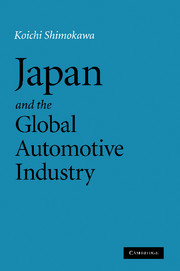Book contents
- Frontmatter
- Contents
- List of figures
- List of tables
- Preface
- Introduction
- 1 Comparing productivity of the Japanese and US automobile industries
- 2 The internationalization of the Japanese automotive industry and local production overseas
- 3 The recovery of European and US auto makers, and relocating and changing lean production
- 4 Early 1990s – the Japanese automotive industry loses international competitiveness, and the development of restructuring strategies
- 5 The restructuring of the global automotive and auto-parts industries
- 6 The restructuring of the world's auto-parts industry and the transfiguration of the keiretsu parts transaction
- 7 Global M&A and the future of the global auto industry – the light and dark sides of merger and re-alignment
- 8 The Asian and ASEAN automotive industries in the global era
- 9 China's automotive industry in the global era, Japanese auto makers, and their China strategies
- 10 Conclusion – the global automotive industry's perspective on the twenty-first century and tasks for the Japanese automotive industry
- Epilogue
- Index
- References
10 - Conclusion – the global automotive industry's perspective on the twenty-first century and tasks for the Japanese automotive industry
Published online by Cambridge University Press: 06 July 2010
- Frontmatter
- Contents
- List of figures
- List of tables
- Preface
- Introduction
- 1 Comparing productivity of the Japanese and US automobile industries
- 2 The internationalization of the Japanese automotive industry and local production overseas
- 3 The recovery of European and US auto makers, and relocating and changing lean production
- 4 Early 1990s – the Japanese automotive industry loses international competitiveness, and the development of restructuring strategies
- 5 The restructuring of the global automotive and auto-parts industries
- 6 The restructuring of the world's auto-parts industry and the transfiguration of the keiretsu parts transaction
- 7 Global M&A and the future of the global auto industry – the light and dark sides of merger and re-alignment
- 8 The Asian and ASEAN automotive industries in the global era
- 9 China's automotive industry in the global era, Japanese auto makers, and their China strategies
- 10 Conclusion – the global automotive industry's perspective on the twenty-first century and tasks for the Japanese automotive industry
- Epilogue
- Index
- References
Summary
In the past quarter century, dynamic and dramatic changes, unimaginable twenty-five years ago, have occurred in the world's automotive industry. This industry started in Europe as car assembly by craftsmen, and then developed dramatically in the US, where a manufacturing system based on mass production was established. The automotive industry in Europe and the US developed along mass-production lines, but in Japan it lagged behind for more than forty years, and nobody would have predicted that Japan would become a world leader. There was a time when the automotive industry was expected to be mature once it entered a certain growth stage, and a kinked growth curve was also much discussed. Almost all of these predictions were completely wrong, and the automotive industry has shown a more dynamic development. Japan's automotive industry took the lead, adding vitality to the whole industry, and contributing a dynamic industrial model.
If the world's automotive industry had not departed from Fordism's mass-production system, and, as W. J. Abernathy pointed out, had stayed an industry, which settled for economy of scale, moving from a learning curve to a mature curve, then it would certainly have become a mature industry, and technology for production, development, and parts might have stagnated. Maturation would not be simply because automobile demand was saturating, but because the industry had lost its dynamism. Certainly, the Japanese and other automobile markets in advanced countries have experienced several periods of growth stagnation caused by saturation.
- Type
- Chapter
- Information
- Japan and the Global Automotive Industry , pp. 294 - 313Publisher: Cambridge University PressPrint publication year: 2010



